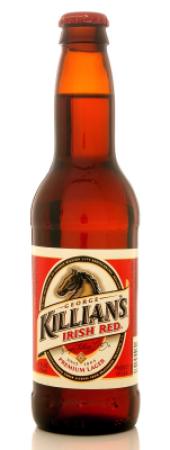
In the debut installment of my ultra-novice beer blogging, we looked at an India Pale Ale. This time around, we're going to look at two different varieties of red beers.
The style guideline for Irish Red Ale (thanks to my friend for linking me to it) says that it should be easy drinking with "an initial sweetness and a roasted dryness in the finish." The reddish color is achieved by roasted barley. Irish red ales are "malt-focused", and usually don't have a noticeable aroma of hops, although several recipes I've found have called for the addition of Kent Goldings hops. A brief Googling turned up this site with three distinct Irish red recipes, and indeed all of them call for roasted barely. The other components seem to vary somewhat. One of them calls for adding honey, another adds chocolate.
2. Killian's Irish Red
Image source (via Google Images)
Killian's Irish Red, named for George Killian Lett, who founded the brewery that crated the originally recipe in Ireland in 1864. It was originally an Irish Red Ale, but is now brewed in America by Coors and is now considered an American style amber lager. The transition was done to give it a broader appeal, and making it a lager took out some of the fullness of it, and reading around on stuff like beer-advocate.com it seems as though people who are big beer aficionados have quite a disliking for it for that reason. This is apparently not unprecedented, though, as makes a note that beers classified as such can be brewed as lagers. Personally, I've always really liked drinking Killian's. I don't doubt that there are better red ales out there which are truer to the whole tradition of the style, but I certainly think Killian's is a good beer and its readily available. I know there's several bars I've been to that have had it available on tap, and if you want to buy a 6 pack of it you can buy it pretty much anywhere.
3. Berghoff Famous Red Ale
This was on tap at an Irish pub in Downer's Grove which I decided to try on a whim. I ended up liking it enough such that I ordered it again the week after when I was there again. The name comes from the historic Berghoff restaurant in Chicago which is now closed, but there's still a line of beers being produced with the Berghoff name, now brewed in Wisconsin. According to Rate Beer's entry for it, its brewed with "Brewer's Two-Row Malt, Caramel 40 Malt, Carapils Malt and domestic hops" and its classified as an American Pale Ale. Two-Row Malt is used as a base for American style beers, Caramel malt--so named for its crystallized sugar--gives (appropriately enough) a caramel flavor and adds to the redness of the color, and carapils are used in pale ales to "balance body and flavor" without adding color. Reviewers on Rate Beer seemed to largely hate this, one review describing it as tasting "metallic." I think it does have a bit of a harshness to it, but I think metallic is a bit of a strong word. It certainly wasn't harsh enough to not make me want to drink it twice.
I've had a number of other red ales in addition to these. I think I've had enough of them to say that really like it as a style, seeing as I really like what are considered some of the "bad" entries of the style by those who study this stuff closely. Perhaps I'll post about more varieties down the road.
Sources: Wikipedia - Killian's, BJCP Style Guidelines, Real Beer.com, Rate Beer - Berghoff, and anything else I linked to above but maybe didn't put down here


